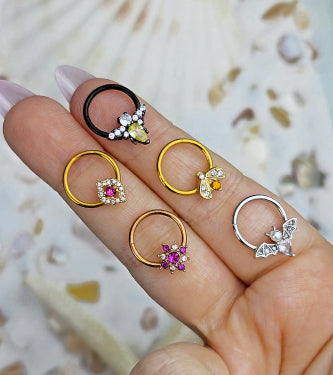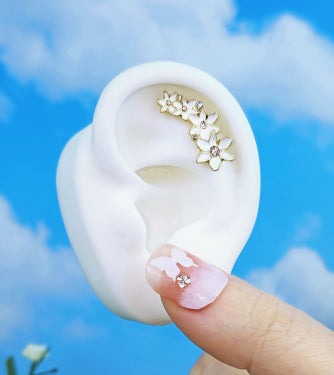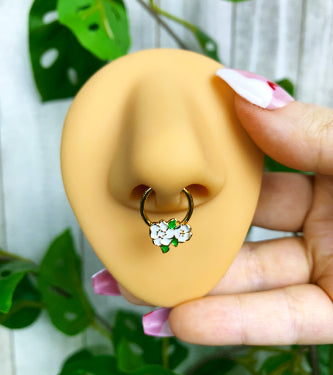Now that it’s been about six weeks, I’ve finally reached that long awaited moment: my belly button piercing is almost entirely healed. Although I would love to claim all of the credit for a fast-healing and relatively painless process up until this point, unfortunately I can’t do that, as this was a collaborative effort between myself, my piercer, and my pocketbook. But I digress; this series is a comprehensive explanation of what it’s really like to have and heal a belly piercing, so let’s get down to business because there are some things I’d love to share.
Part 3: What to Expect
Weeks 0-2
We’ve already covered what it feels like to have this piercing done, but I feel like there are a few general things that anyone who wants a belly piercing (especially if it’s their first body piercing) should know.
1. Once this is done, you’ll feel it. It won’t really hurt, but it may very well be slightly uncomfortable for several days to a couple weeks, and by feel it I mostly mean that you’ll be pretty much constantly aware that there is something in your skin. It may be a tad annoying if you aren’t used to it, but this is actually a good thing because it’ll keep you from forgetting it’s there and causing an infection by brushing or tapping it a lot.
2. Cleaning might be unpleasant the first few days, but you’ll realize after a week or so that if you do experience some general discomfort, the cleaning actually alleviates a lot of it. Sea salt soaks are also a great pain management tool, and I personally find them rather relaxing. The bottom line though is that unless you have an allergy or your piercer specifically says not to, it’s perfectly okay to do whatever you usually would for pain, and most painkillers will help with the swelling too, so it’s a total win-win.
3. There are a bunch of things that might be slightly scary that are actually totally normal for a new piercing. Amongst those listed in most piercing pamphlets or informational articles are redness, swelling, bruising, a little bleeding, clear fluid that might dry crusty around the jewelry, and mild itching.
*Everyone is different, but at some point in the past six weeks I’ve had literally all of these symptoms. Basically once the initial swelling went down I bled tiny bits for the first week and was bruised for a little while. The top hole or “exit wound” of my piercing had a little redness around it up until just a few days ago, and in the past ten days or so there’s been some itching and a very little bit of crustiness.
**If you itch like crazy, swell a whole lot, get a feeling of hot or tingly skin, or have more pain than usual accompanied by puss or excessive fluid, it may mean you have an irritation or a mild infection, so it’s always good to contact your piercer, who will sometimes recommend you see a physician.
Weeks 2-4
During this time is when I could really tell that it was starting to heal. Swelling was down almost completely, there was less redness ( though it was still there), and the movement that happened during cleaning didn’t really hurt or bother me. If you’re at all like me, you’ll get really excited when you notice these changes, but be careful not to jump the gun because the inside of the piercing is still definitely tender and needs to be treated with kid gloves.
*By the four week mark, you probably won’t be able to feel it anymore, so you’ll have to be really careful not to hit, swipe, brush, pat, knock or otherwise yank your belly ring. Speaking from personal experience, not only can one good yank or swipe extend your healing time, but it can also be painful depending on just how bad the offense was. I caught the top ball on my sleeve once during cleaning and the whole thing was a bit ouchy for about two days afterwards. Very sad.
**Now that the swelling is down, it’s easier for bacteria to get inside the piercing, so make sure to keep strictly to the cleanliness regimen. I have a compromised immune system myself, so I was super nuts about disinfecting, but there’s no reason someone with a hardy constitution shouldn’t be too. I used a new towel every time I showered, changed to a whole new outfit of freshly cleaned clothing (using fragrance, color, and chemical free detergent of course) after each of my main cleanings (once a day), washed my sheets and pillow cases twice a week, cleaned with cue tips instead of my hands, and used Lysol disinfecting wipes on all my bathroom surfaces every time I went to do a salt soak or a cleaning.
Weeks 4-6
If you’ve taken care of yourself and done everything your piercer told you to, by week six you should be almost healed up. Movements that used to be uncomfortable don’t bother you anymore, ab work-outs are easier to accomplish, sleeping heavy is less troublesome, and the car seat belt will no longer annoy you to death. A few things you should know if you don’t already:
1. Most professionals recommend that once a piercing feels fully healed you continue the prescribed aftercare regimen for at least another six months to insure no infections or scarring.
2. Even when it feels fine, your piercing may still be on the mend inside and skin can take up to a year to entirely accept a foreign object and regain it’s full health, so most piercers will tell you not to change from the body jewelry you were pierced with until at least the six month mark. If you absolutely have to change it up, the best idea is always to go back to the piercer and have them do it in a sterile environment.
3. Dangling belly rings are gorgeous, but there are a few general rules to follow in order to be sure they don’t cause your relatively new piercing any problems; Make sure that when you sit down there’s at least a half inch between the end of your dangling piece and the waist of your pants, clean any chains or intricate decoration regularly with antibacterial soap, try not to sleep with a long dangle on, and check any dangling or moving parts regularly to make sure nothing is loose and all edges are smooth.



